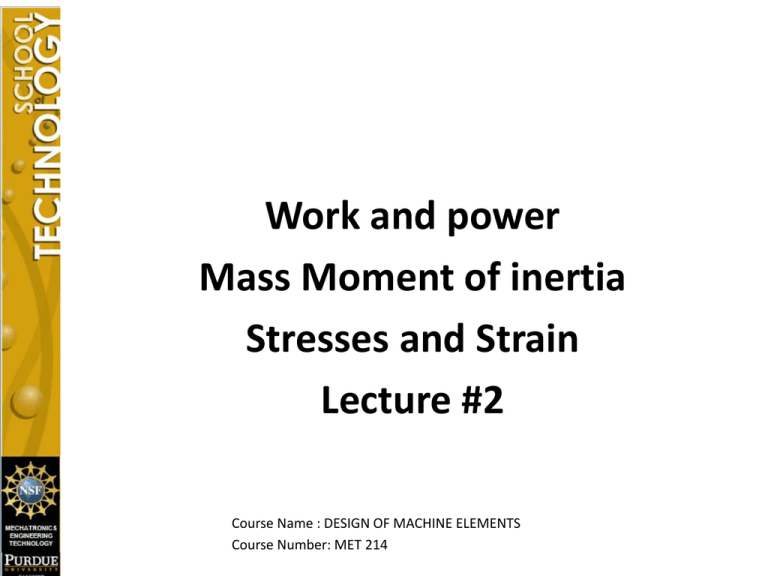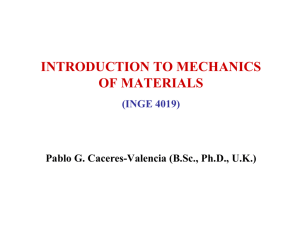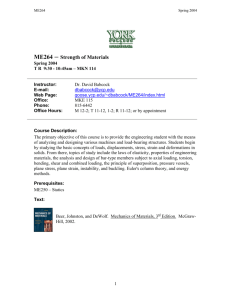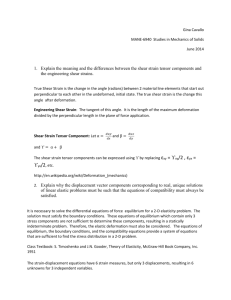Lecture #2
advertisement

Work and power Mass Moment of inertia Stresses and Strain Lecture #2 Course Name : DESIGN OF MACHINE ELEMENTS Course Number: MET 214 Work and power In order to establish the links that exists between the design of machine elements and dynamics and/or Control theory, consider the following derivation relating mass moment of inertia to polar moment of area. Recall definition for work W=F∆X where W= Work (ft-lbs) (N-m) F= Force (lbs) (N) ∆X = distance (ft.) (m) Using relationship for ∆X = r ∆θ developed in the previous lecture for rotational systems, W=Fr ∆θ T=rF = Torque in-lbs,ft-lbs,N-m W=T ∆θ ∆θ=radians To relate work to Power, note the following: power is the rate at which work is performed. P W t P F 1 1 X W FX F F t t t where P=Power ft-lbs/sec-> 550 ft-lbs/sec = 1HP For angular measures note the following P W t 1 1 W T T T t t t P T Since Tω is describing the power in angular measures for the same device for which F is describing in linear measures we have the following situation T F With these considerations in mind, we can now formulate Newton’s 2nd law of motion for rotational systems. Consider the situation below. The illustration depicts a solid cylinder free to rotate about an axis of symmetry having a cross sectional area on the ends of A, a length of h, and made of a material having a density of ρ. Power existing or associated with the cylinder is due to the combined effects of the power existing and/or associated with each of the elemental mass elements comprising the cylinder. where Pm = Power associated with each elemental mass in the P T F Pm cylinder m m = Sum up the power Pm for every mass element in cylinder Using relationships previously established T Fmm m T (mm am )(rm ) m T (mm rm )(rm ) m T rm2 mm m T rm2 mm m F ma T J m Where J m mass moment of inertia J m rm2 mm m Notice how Newton’s 2nd law for rotational systems has a form similar to Newton’s 2nd law for linear systems. Jm= ft2 slugs = ft lb sec2 = m2Kg = N-m sec2 Just as we did for Newton’s 2nd law with linear motion, we can also manipulate Newton’s 2nd law for angular position as a function of time for a constant level of torque applied to a body of mass M. T J m d T Jm dt d 2 T Jm dt 2 Where 0 (t ) Jm (t ) 0 t 1 2 (t ) 0 0t t 2 angular velocity at time t=0 angular velocity at time t angular acceleration mass moment of inertia Notice that similarities exist between mass moment of inertia and polar moment of inertia for area. Let us investigate the relationship existing between the two types of inertia. J m rm2 mm J r2 A To understand the relationship between J m and shown below. J , let us rewrite J m in terms of other variables as mm (vol ) m J m rm mm 2 m vol- volume of mass element ρ- density of mass element m m m m t m - thickness of mass element Summing the thickness of each mass element stacked one upon another yields the following. r A t 2 h rm2 Am m t m h J m hJ Using established formulas for J from text books concerning strength of materials 2 d Note A of cross section = 4 4 Jm h d 32 d2 J m hA 8 d2 J m volT 8 2 d 4R 2 1 Jm MT MT M T R2 8 8 2 Where M T total mass of cylinder R outside radius of cylinder J will be used to relate the stress levels in shafts to the geometry of the shafts JM will be used to relate torque and angular acceleration. As can be seen by the relationship existing between JM and J, the design of a shaft to accommodate various stress levels influences the motion capability of the shaft. Example: To reinforce the linkage existing between mass moment of inertia, and its influence on motion characteristics, consider the situation shown below. Cylinder made of material having density of ρ Assume the cable connecting weight w to the cylinder is tight at t0 =0, the platform is removed enabling the weight to drop. Perform the following 1. Draw free body diagram for weight w valid for t>t0 =0 and provide equation describing motion of w in terms of w, tension in the cable FT and an inertia force w a g where a is the acceleration of weight w after platform is removed. FI 2. Develop an equation of motion describing the cylinder valid for t> t0 . Use FT and R0 to express torque generated by weight and sum with the inertia force Jmα Express α in terms R0 and a and solve resulting equation of motion associated with cylinder for FT. 3. Substitute expression for FT in terms of Jm, R0, and the acceleration a into expression developed in step 1 and solve for acceleration a in terms of w, g, R0 and Jm . 4. Describe impact of Jm on the acceleration a i.e. if Jm increases describe impact on a. If Jm decreases, describe impact on a. Describe 3 variables that can be used to effect the value of Jm and discuss how variations in the variables effect Jm. Stresses and Strains When machine elements are subjected to externally applied loads, internal reactions are created within the elements as required by Newton’s third law. The internal reactions generated within the element oppose the applied loads in an effort to maintain equilibrium to an extent permitted by the material characteristics and/or geometry associated with the elements. Due to the complexities that exist with internal reactions in general, a variety of stresses and strain types are defined to facilitate the systematic categorization, comparisons and/or characterization of the internal reactions generated in response to externally applied loads. Normal stresses and strains: The following geometric considerations are utilized in the definitions concerning normal stresses and strains Prismatic bar: A bar having a uniform cross sectional along the entire length of the bar. Two possibilities exist for how forces may be applied to the ends of a prismatic member as shown below. The internal reactions resulting from internal force distributions that are perpendicular to the cross sectional area of a prismatic bar can be characterized by the definition provided below. σ = F/A where σ = normal stress lb/in2 lb/ft2 N/m2 F= Force acting along centroidal axis of a prismatic member lb, N A = Cross sectional area of prismatic member in2, ft2, m2 When externally applied forces tend to stretch a bar, the normal stresses generated are referred to as tensile stresses. When the externally applied forces tend to compress a bar, the normal stresses generated are referred to as compressive stresses. Note: For same level of Force F applied to a bar, as A increases then σ decreases. Consequently, the geometry of machine elements effects the stress levels in the elements and can be used to control the level of stress existing in a member. Material selection is also a consideration when designing a member since different materials have different strength characteristics. Distribution of internal reaction forces associated with externally applied axial forces is shown in the figure below To create circumstance that will enable systematic comparisons to be made of the extent externally applied axial forces effect a change in the length of a bar being stretched or compressed by the forces (independent of the original length of the bar), the following definition is utilized where normal strain or engineering strain in/in m/m dimensionless l change in length bar experiences as a result of applied forces (in,m) deformation, alternative term used to describe Δl l original length of bar, length of bar prior to being subjected to applied loads (in,m) Under a sufficiently wide range of circumstances, the strain experienced by a prismatic bar due to externally applied axial forces can be related to the normal stress generated in response to the applied axial forces by the following equation which is referred to as Hooke’s law. where E modulus of elasticity lb/in2 lb/ft2 N/m2 E l l l The value of E associated with any particular prismatic bar depends on the material used to fabricate the bar. To assess the characteristics of the bar that are characterized by the value of E, solve for Δl in terms of E and note trends in Δl as E changes. E F l F l E l A l A E For the same level of force F applied to a bar having cross sectional area A and an initial length l, a bar with the greater E will experience the smaller Δl. As E increase then Δl decrease Hence E is a measure of stiffness, i.e. a material with a large E value offers more resistance to changes in length to an applied load than a material with a smaller E value. Note: E1 is an equation of a line and may be plotted on a graph as shown below. Note E1 represents the slope of the graph y=mx+b where b=0 E Q) If a second material having a modulus E2>E1, is plotted on the graph shown above, where would the line represented by E2 lie relative to the line for E1 shown in the graph? For large values of externally applied forces, the relationship between stress and strain will depart from the linear expression provided previously. Graphs can be utilized to describe behavior under all stress levels incurred up to fracture. Key points to note on graphs P Proportional limit: Maximum stress value for which relationship between stress and strain E Y (a b) Yield point: The value of stress at which strain increases without an increase in stress. Since strain increases without an increase in stress -> Stress strain curve is nearly horizontal. Analogy: think of hot taffy candy- the candy will stretch with little or no effort. Ductile materials with yield point -> Low Carbon steel YS Yield strength: The stress that will cause the material to undergo a certain specified amount of permanent strain after the load is removed, i.e. bar does not return to its original length due to being permanently strained. Value of strain utilized to establish yield strength is typically ε =.2 percent. Ductile material with no yield pointaluminum. U Ultimate strength: Maximum value of stress exhibited on stress strain graph. B Breaking Strength: Stress level existing in bar when bar fractures A Allowable Stress: The value of stress that a machine element should not exceed for safe operation If loading is known, the minimum cross sectional area required to prevent the stress from exceeding an allowable level can be determined. F F A A A F A Given a maximum value for F, choose A such that σ is always less than σA , Note: as A increases then σ decreases Find Amin = F/ σA To avoid generating stress levels in an element that will exceed σA for the loads anticipated, choose A> Amin. The factor of safety is defined as the ratio of some load that represents the strength for the member to the actual load existing in the member. For ductile material such as low –carbon steel, a factor of safety could be based on the yield point stress. Accordingly, the following relationship holds. fs = 𝑆𝑦 𝜎𝑎 Where 𝑆𝑦 = yield stress in tension fs = factor of safety Note: The symbol N will also be used in subsequent lectures to refer to the factor of safety To provide a visual summary of how the normal stress varies along the length of a bar, the amount of normal stress existing at various internal cutting planes can be plotted as a function of position along the length of the prismatic bar as shown below. Organizing information in this manner facilitates calculating overall changes in the length of a bar exposed to a complicated loading geometry and/or to assist in selecting bearings exposed to axial loads, referred to as thrust loads. Sign convention: Force and displacement are considered positive if they cause tension and elongation. A negative force and displacement will cause compression and contract respectively. A/ D PL (5kN ) LAB (3kN ) LBC (7 kN ) LCD AE AE AE AE Shear stresses result when the internal reaction force distributions generated in response to externally applied loads are orientated parallel to a cutting plane and/or lie in the cutting plane as opposed to being perpendicular to the cutting plane as in the case of normal stresses. A variety of situations can create internal reacting forces that are parallel to and/or lie in a plane. Externally applied loads that result in internal shear reactions can be characterized by the definition provided below. avg F / A where avg Average shear stress (lb/in2; lb/ft2; N/m2) F Force lying parallel to cross sectional area A. (lbs, N) A Cross-sectional area (in2; ft2; m2) Note: The above definition applies only to forces that are assumed to be uniformly distributed across the planar area. More complicated distributions will be discussed later. When externally applied loads create internal reaction force distributions that lie in and/or are parallel to a plane, the body containing the plane tends to undergo angular distortions. Visualizing the motor mount as comprised of many thin layers with each layer slid slightly with respect to an adjacent layer in response to the externally applied load enables the angular distortion accompany the load to be characterized. To enable comparisons to be made of the extent externally applied forces effect a change in angular orientation(distortion) of a body, the following definition is utilized for shear strain. s s L where s shear strain (in/in ft/ft m/m) s Displacement parallel to direction of load (in, ft, m) L Characteristic length perpendicular to displacement Hooke’s law relating shear stress and shear strain of elasticity in shear, or shear modulus or modulus of rigidity G whereG modulus 2 (lb/in , lb/ft2, N/m2) To assess the characteristics quantified by the property G, rearrange Hooke’s law and solve for s . S G s F FL s L AG AG Assuming the same shear stress distribution is created in two objects that are similar geometrically, for the same level of τ, less deformation s occurs in the object made from a material having a larger G. Hence G is a measure of resistance to deformation or stiffness. For large values of externally applied forces, the relationship between shear stress and shear strain will depart from the linear expression idealized by Hooke’s law. Graphs can be utilized to describe behavior under all stress levels incurred up to fracture. Curves generated from data gathered during torsion testing to characterize the shear stress versus sheer strain relationship for a material exhibit features similar to those existing with normal stress and normal strain diagrams. Shear Modulus: This value represents the slope of the straight line portion OA of the diagram. The coordinates of point A are (0.008 rad, 52 ksi). Thus, 52ksi G 6500ksi 0.008rad The equation of line OA is therefore τ=6500 φ , which is Hooke’s law for shear. Proportional Limit: By inspection, the graph ceases to be linear at point A. Thus, pl 52ksi Ultimate Stress: This value represents the maximum shear stress, point B. From the graph, u 73ksi The factor of safety can also be applied to shear stresses 𝑓𝑠 = 𝑆𝑌 ′ 𝜏𝑎 Where 𝑆𝑌 ′ = 𝑌𝑖𝑒𝑙𝑑 𝑠𝑡𝑟𝑒𝑠𝑠 𝑖𝑛 𝑠ℎ𝑒𝑎𝑟 𝜏𝑎 = 𝑎𝑙𝑙𝑜𝑤𝑎𝑏𝑙𝑒 𝑠ℎ𝑒𝑎𝑟 𝑠𝑡𝑟𝑒𝑠𝑠 For ductile materials , typically it is assumed 𝑆𝑌 ′ = 0.5 𝑆𝑌 . Shearing stresses on planes at right angles Consider an elemental element subjected to shear stress on one face of the element. Since the element is in equilibrium, shear stresses must exist on the other sides of the element that will satisfy the laws of statics. The resulting stress distribution is shown below and is designated as pure shear.
![Applied Strength of Materials [Opens in New Window]](http://s3.studylib.net/store/data/009007576_1-1087675879e3bc9d4b7f82c1627d321d-300x300.png)




